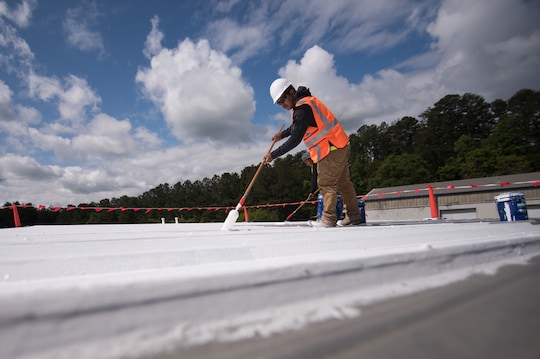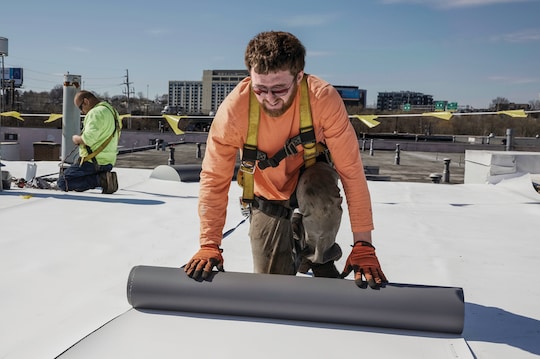
Por lo general, los techos de metal son conocidos por su bajo mantenimiento, aspecto estético y un acabado que los protege del sol y daño por agua. Sin embargo, luego de muchos años, ese acabado puede desvanecerse o deteriorarse. Luego el propietario de edificio debe decidir si debe restaurar o reemplazar su techo.
Mientras que hay algunas situaciones donde el reemplazo es necesario, la restauración de techos de metal pueden ser más accesibles de lo que la gente piensa. Y restaurar los techos de metal de tus clientes en lugar de reemplazarlos puede disminuir el costo total mientras ahorra tiempo y gastos de mano de obra para ti.
¿Cuándo deberías recomendar su reemplazo?
Antes de que comiences a considerar las opciones de restauración, necesitas evaluar si el techo es candidato para la restauración. Si uno o más de los siguientes problemas están presentes, el techo probablemente no será un buen candidato para la restauración y debe reemplazarse:
- El techo no es estructuralmente seguro. Si el metal está corroído en áreas que debilitan la estructura, entonces las partes del techo pueden necesitar reemplazo.
- Hay tapajuntas y conexiones con pérdidas. Se necesita abordar cualquier posible pérdida antes de intentar restaurar el techo. Si las tapajuntas no son resistentes al agua, se deben quitar o reemplazar.
- El acabado existente del techo de metal muestra deterioro significativo. Corrosión o daño significativo es señal de posible falla en el techo.
Beneficios de la restauración
Hay varias posibles ventajas de la restauración de techo de metal.
La primera es el costo de la restauración. Es más económico restaurar el techo de metal que reemplazarlo. Además, la restauración no afecta a los ocupantes del edificio, y no requiere exponer la estructura a los elementos.
Adicionalmente, la restauración pueden extender la vida útil del techo de metal. Es posible que un techo se restaure más de una vez siempre que el sistema de techado de metal se mantenga en buen estado. Esto puede ahorrarte a ti y tus clientes molestias y dinero a largo plazo.
Puede haber beneficios ambientales al elegir restaurar. Al optar por reparar el techo en lugar de reemplazarlo, estás enviando menos materiales a los vertederos. Los colores reflectores del techo, como el blanco, también pueden ayudar a reflejar el sol lejos del techo y bajar la temperatura del techo.
A Five-Step Process for Commercial Metal Roof Restoration
Entonces, ¿cómo se restaura un techo de metal? Un método confiable es cubrir el techo con una capa de membrana líquida. Este tipo de sistema ofrece una aplicación fácil con pocas herramientas o accesorios, ayudando a proteger al techo de metal estructuralmente seguro de los efectos dañinos de los rayos UV y mal clima.
Estos son los aspectos básicos de la restauración de un techo:
- Limpia la superficie del techo con escobas, espátulas y una hidrolavadora. Asegúrate de eliminar cualquier desecho suelto o revestimiento viejo. Necesitarás una superficie lisa y seca antes de comenzar el proceso de restauración.
- Prueba la adhesión a la estructura del techo al aplicar un poco de capa base y tela de poliéster y dejarlo secar. Si el producto no se adhiere correctamente, entonces necesitarás una capa de imprimador.
- Prepara los tapajuntas y las juntas con una tela de poliéster y un sellador para tapajuntas. Pinta una capa de sellador con una brocha, coloca una pieza de tela de 12" de ancho sobre el tapajuntas o junta, y luego pinta otra capa de sellador encima. Alisa la tela para asegurarte de que no haya burbujas de aire ni arrugas, sellar completamente el tapajuntas o junta.
- Aplica la capa de base a una pequeña área del techo usando una brocha para techos. Coloca la tela de poliéster no tejido arriba, y aplica otra capa de capa base. Recuerda alisar la tela para eliminar cualquier burbuja de aire. Luego continua aplicando la capa base y la tela hasta que el techo esté cubierto. Superpone los lados de los rollos de la tela por cuatro pulgadas y superpone el extremo del rollo por seis pulgadas. Deja esta capa secar durante 24 horas.
- Cubre todo el techo con la capa final usando una pistola a presión, con cobertura como se indica en las especificaciones del producto. Deja secar la capa final durante 24 horas y luego aplica otra capa final.
Los sistemas de revestimiento como el sistema de techo HydroStop PremiumCoat de GAF ofrecen un sellado resistente a las condiciones climáticas sobre techos de metal existentes, protegiendo y extendiendo la vida de dicho techo. Una vez completada la restauración, un techo de metal a menudo dura varios años antes de volver a restaurarlo; ayudando a tener tranquilidad tanto para ti como para tus clientes.



